Parthenium hysterophorus (parthenium weed)
Identity
- Preferred Scientific Name
- Parthenium hysterophorus L.
- Preferred Common Name
- parthenium weed
- Other Scientific Names
- Argyrochaeta bipinnatifida Cav.
- Argyrochaeta parviflora Cav.
- Parthenium glomeratum Rollins
- Parthenium lobatum Buckl.
- International Common Names
- Englishbarley flowerbastard feverfewbitterweedbroomweedcarrot grasscongress grasscongress weeddog flea weedfalse ragweedfeatherfewfeverfewmugwortragweed partheniumSanta Maria feverfewstar weedwhite topwhite top weedwhiteheadswild wormwoodwormwood
- Spanishajenjo cimarronamargosacamaloteescoba amargahierba amargosaistafiaterequeson
- Frenchfausse camomillematricaireparthenium matricaire
- Portuguesementruz
- Local Common Names
- Belizecorientesiiusilantro
- Brazilcoentro-do-matofazendeirolosna-branca
- Caribbeanfeverfew
- Chinayin jiao ju
- Cubaartemisillacofitilloescoba amarga
- Dominican Republicbaille lameescoba de Puercoescobita amargafriega platosyerba amargayerba blancayerba de burroyerba mala
- Ethiopiaarama-kubaarama-sorgobiyabassachebchabedayessafaramssissakalignoleqincheterekabi
- Guatemalahauaytacana
- Haitiabsinthe marronbalai amerfeuilles bautonfeuilles boutoparthene multifide
- Hondurasajenjoescobilla
- Indiabhoothkedacarrot weedchatak chandaniCoimbatore chedicongree grasscongress pachagajar ghasgazar ghaskeepa gedaosadi
- Jamaicadog-flea weedwhitetop
- Mexicoaltamisaaltamisa cimarronaaltamisa del campoaltamisillaarrocilloartanizachailecicutillacola de ardillaconfitillofalsa altamisahauayhierba amargosahierba del burrohierba del gusanohuachicholejihuite amargomanzanilla del camporomerillotzail-cuettzaileyerba de la ovejazacate amargo
- New Caledoniafausse camomille
- Nicaraguamanzanilla montera
- Pakistanbabyflowergandhi bootilewanai bhang
- Puerto Ricoajenjo cimarrónartemisa cimarronayerba amarga
- Saint Luciamatnitjenwhitehead
- South Africafamine weed
- SwedenFlikparthenium
- USAfalse ragweedquinine-weedragweed partheniumSanta María
- EPPO code
- PTNHY (Parthenium hysterophorus)
Pictures
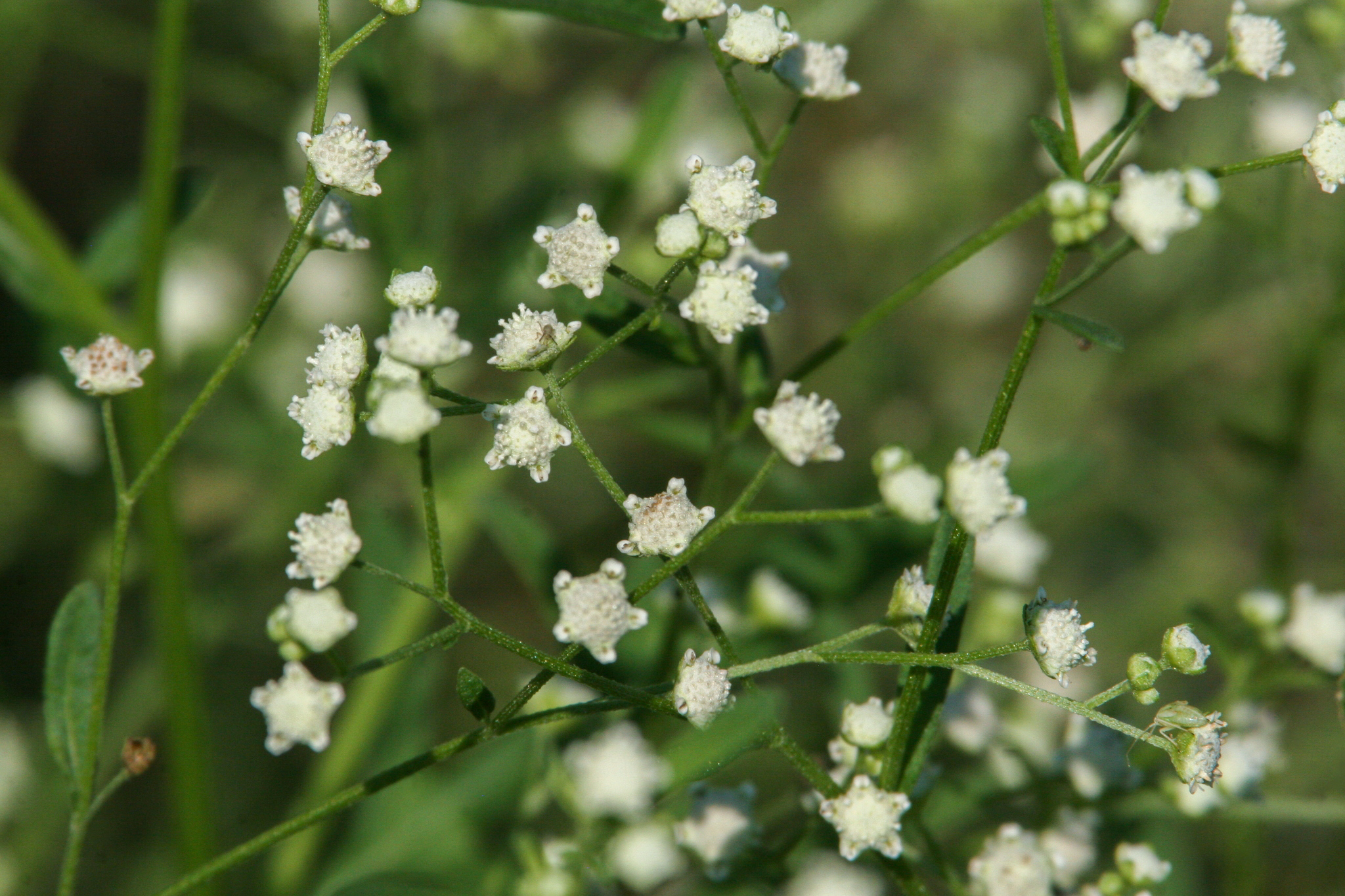
Flowering habit
Parthenium hysterophorus (parthenium weed); Flowering habit. Combine, Texas, USA. September 2016.
©L. K. Holt/via iNaturalist - CC BY 4.0
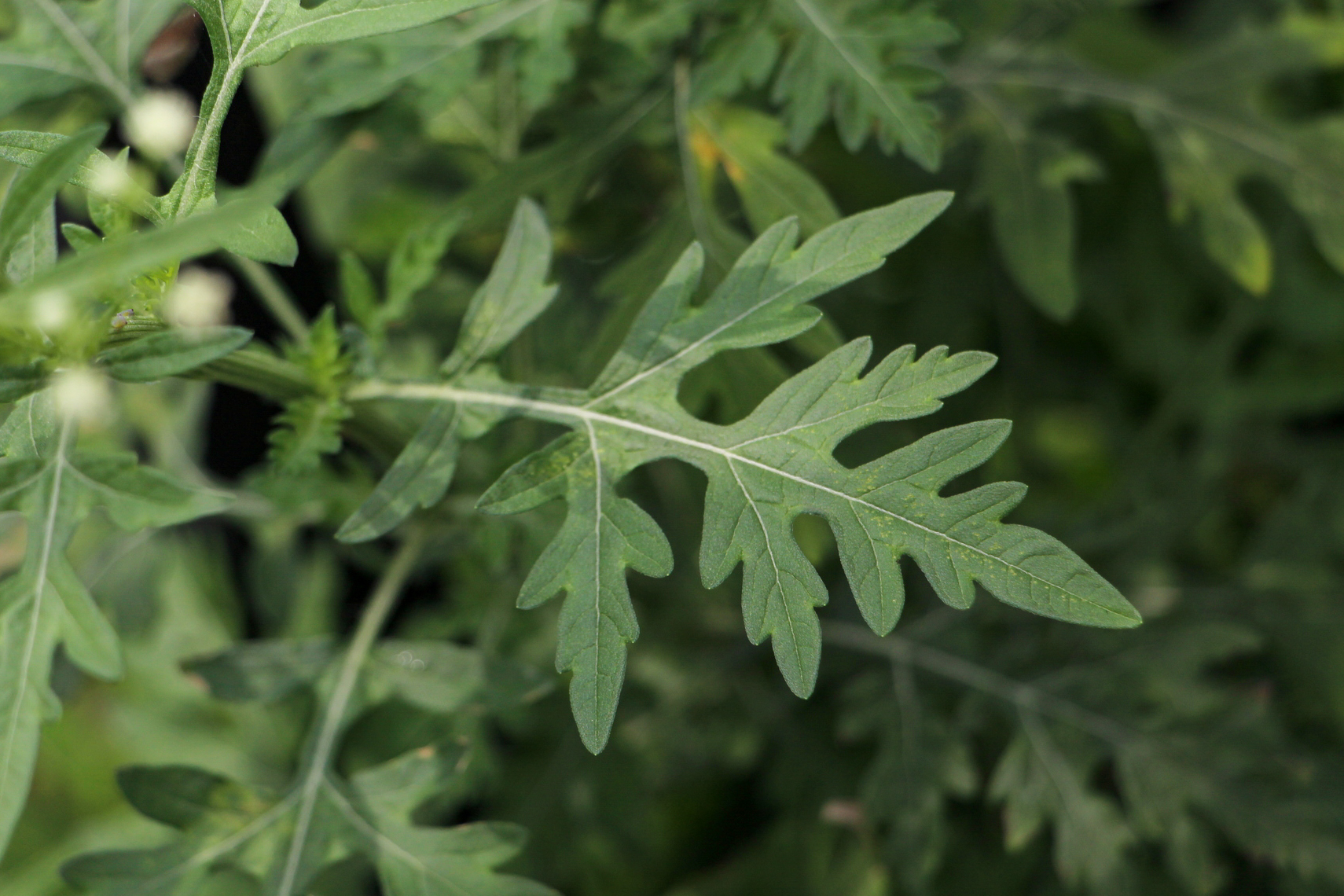
Leaf
Parthenium hysterophorus (parthenium weed); Leaf. Cali, Valle del Cauca, Colombia. December 2021.
©Andrés Ramírez-Barrera/via iNaturalist - CC BY 4.0

Foliage
Parthenium hysterophorus (parthenium weed); Foliage. Nanzih District, Kaohsiung City, Taiwan. October 2021.
©五色鳥 (ssnp129)/via iNaturalist - CC BY 4.0
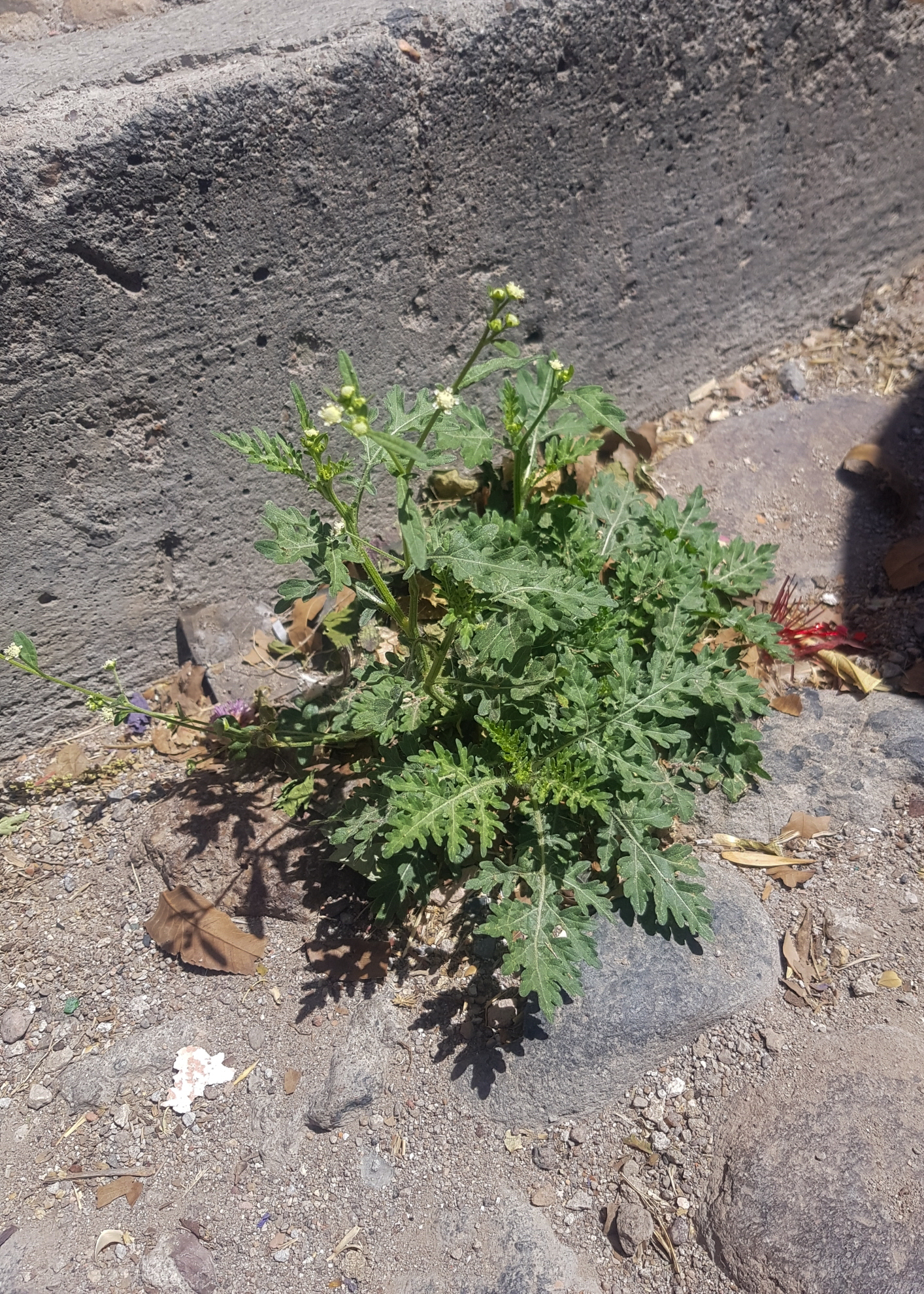
Habit
Parthenium hysterophorus (parthenium weed); Habit. San Miguel de Allende, Guanajuato, Mexico. April 2021.
©ASRS (arribarivas)/via iNaturalist - CC BY 4.0
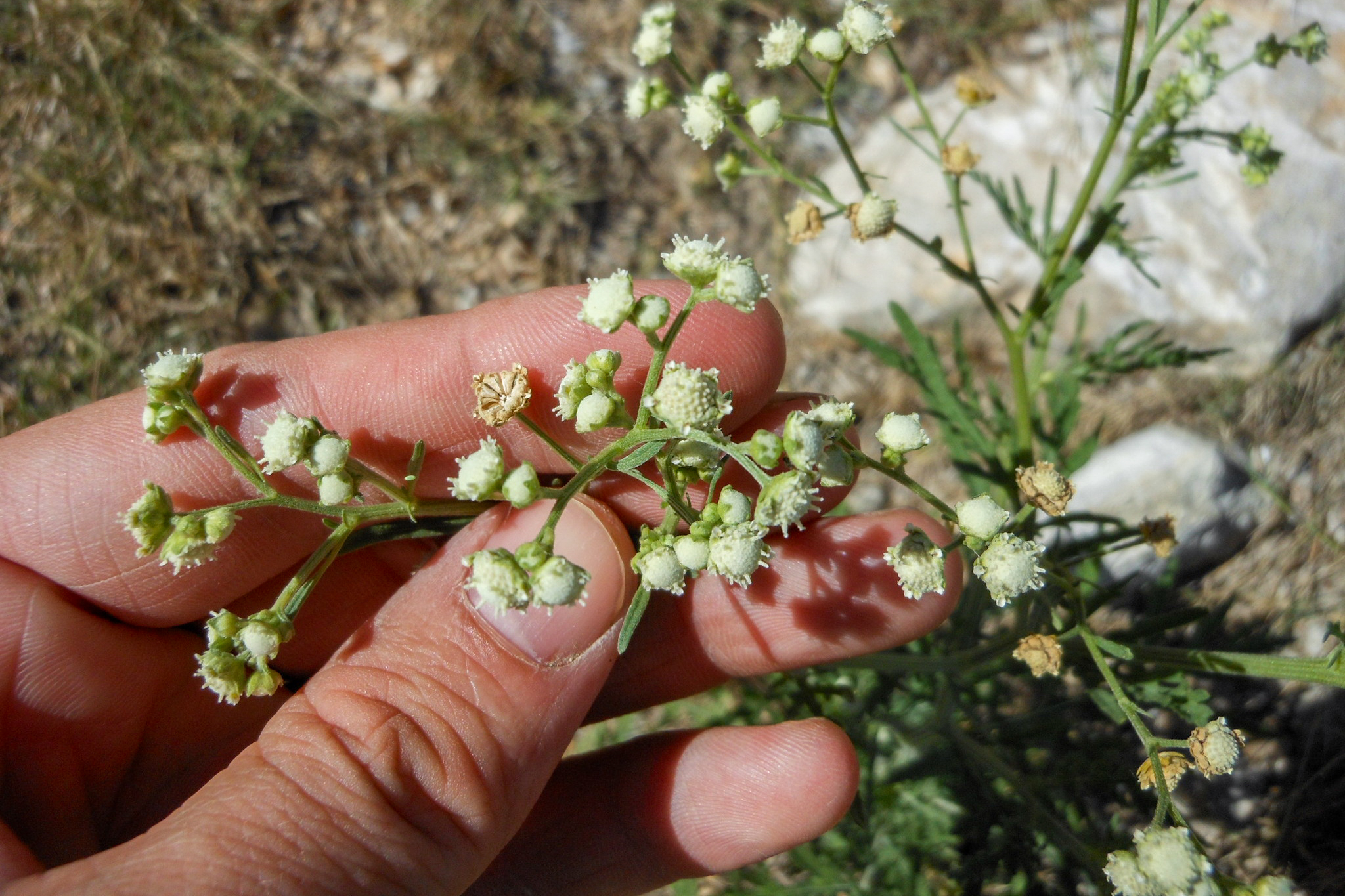
Flowers
Parthenium hysterophorus (parthenium weed); Flowers. Fort Worth, Texas, USA. September 2012.
©Sam Kieschnick (sambiology)/via iNaturalist - CC BY 4.0
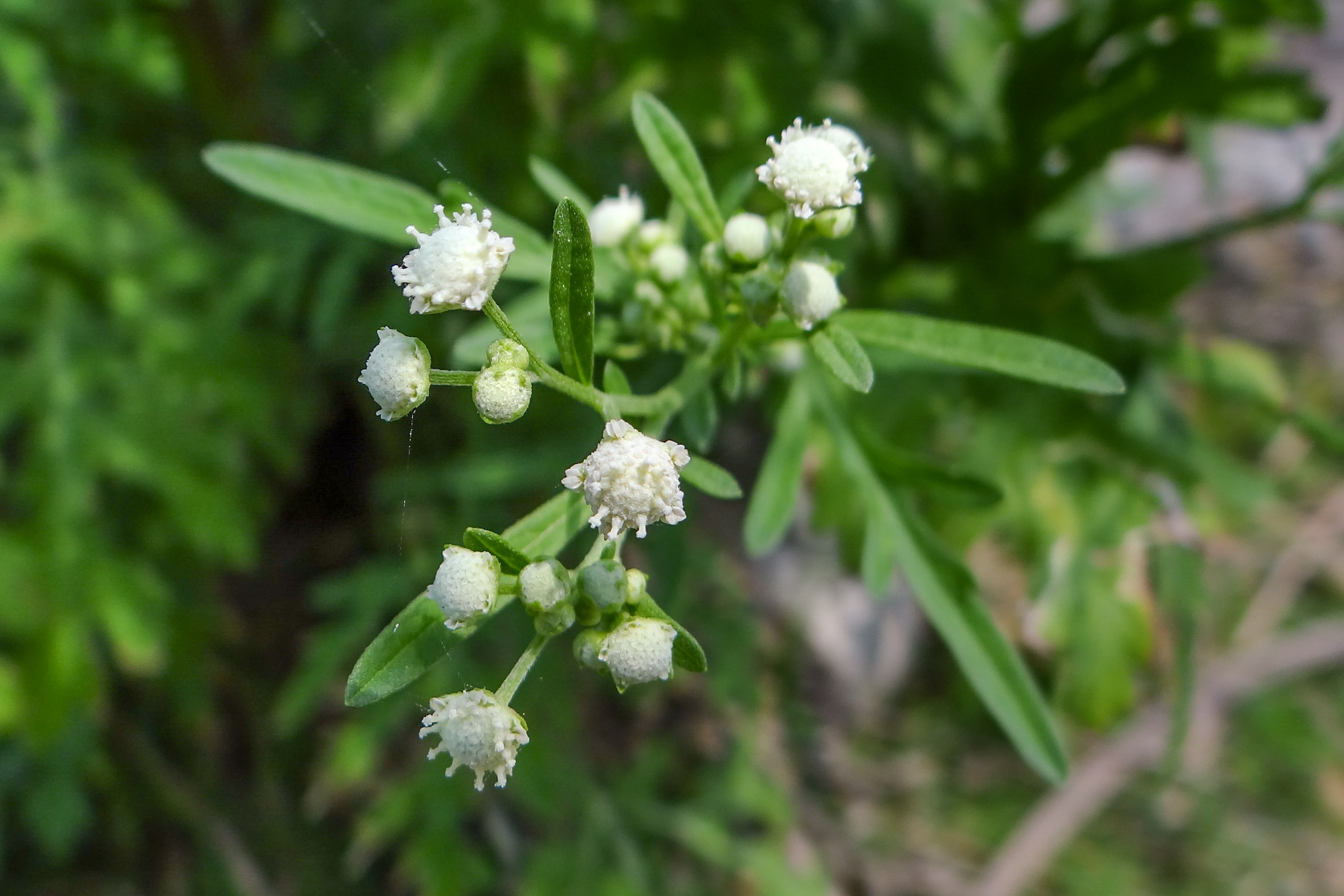
Flowers
Parthenium hysterophorus (parthenium weed); Flowers. Kenting National Park, Taiwan. March 2013.
©呂一起 Lu i-chi (pchi45)/via iNaturalist - CC BY 4.0
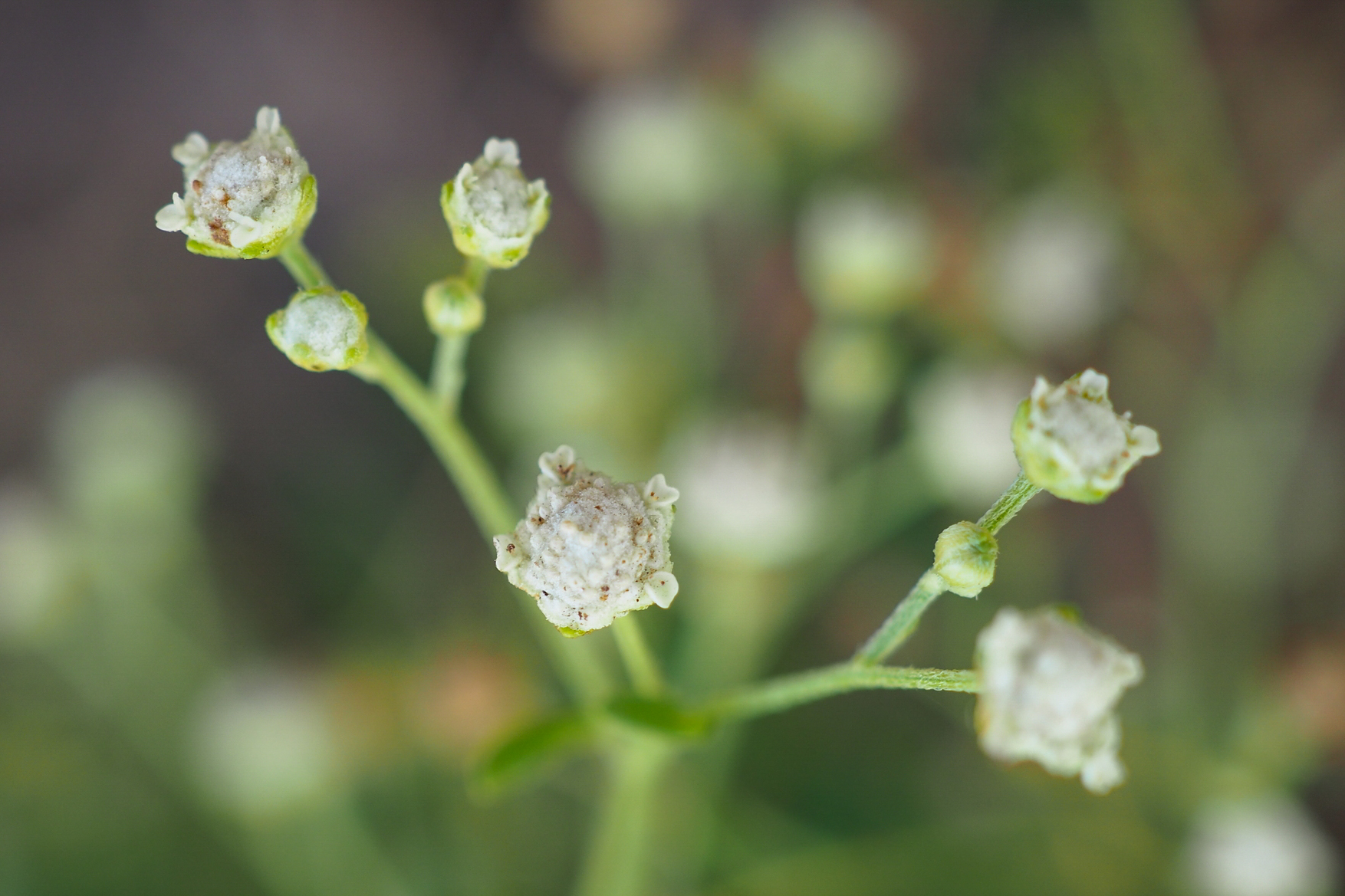
Parthenium hysterophorus (parthenium weed); Flowers. Saint Pierre, Réunion Island. January 2021.
©Augustin Soulard/via iNaturalist - CC BY 4.0
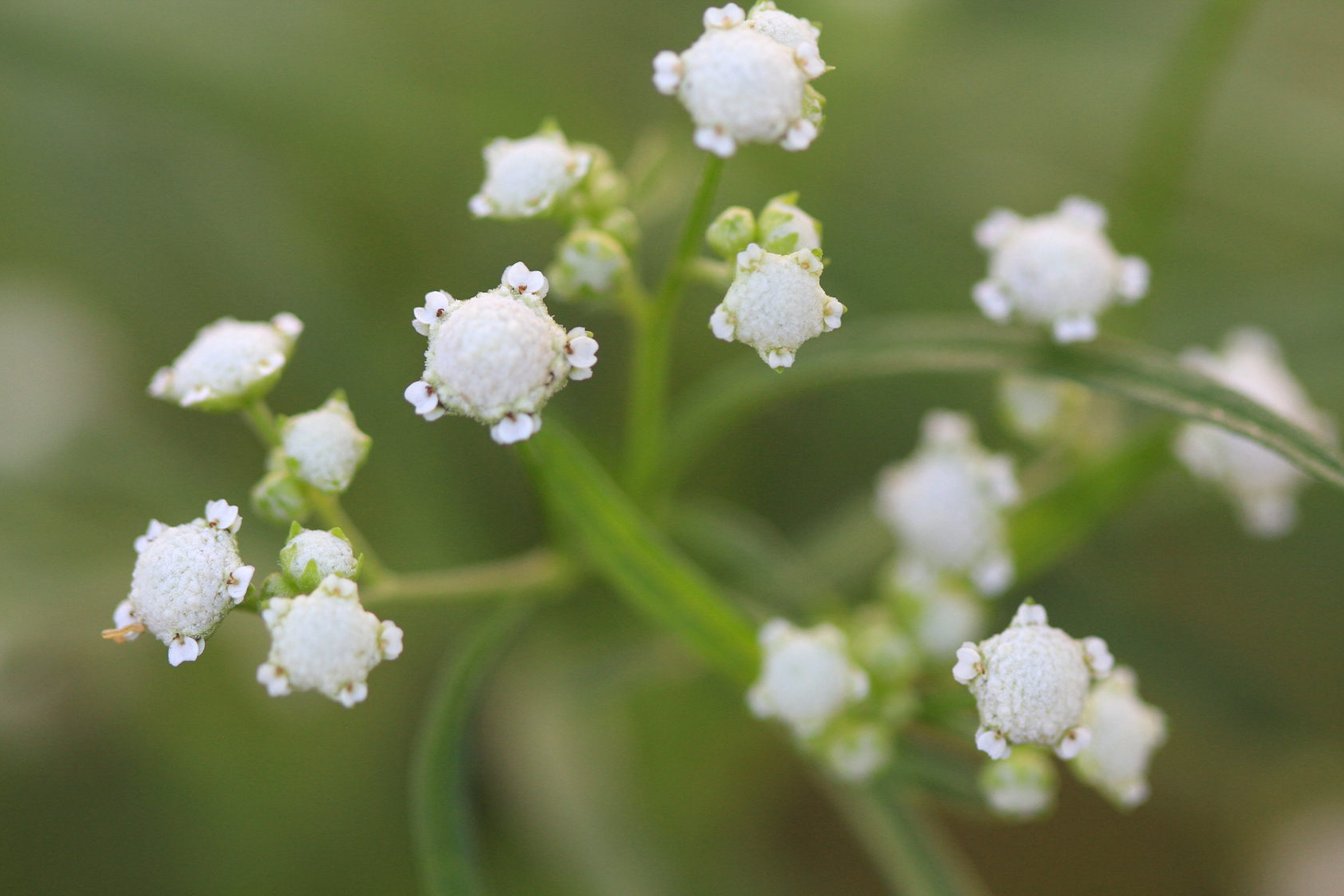
Parthenium hysterophorus (parthenium weed); Flowers. Ouest Department, Haiti. February 2018.
©Brian Oakes Haiti Hunter/via iNaturalist - CC BY 4.0
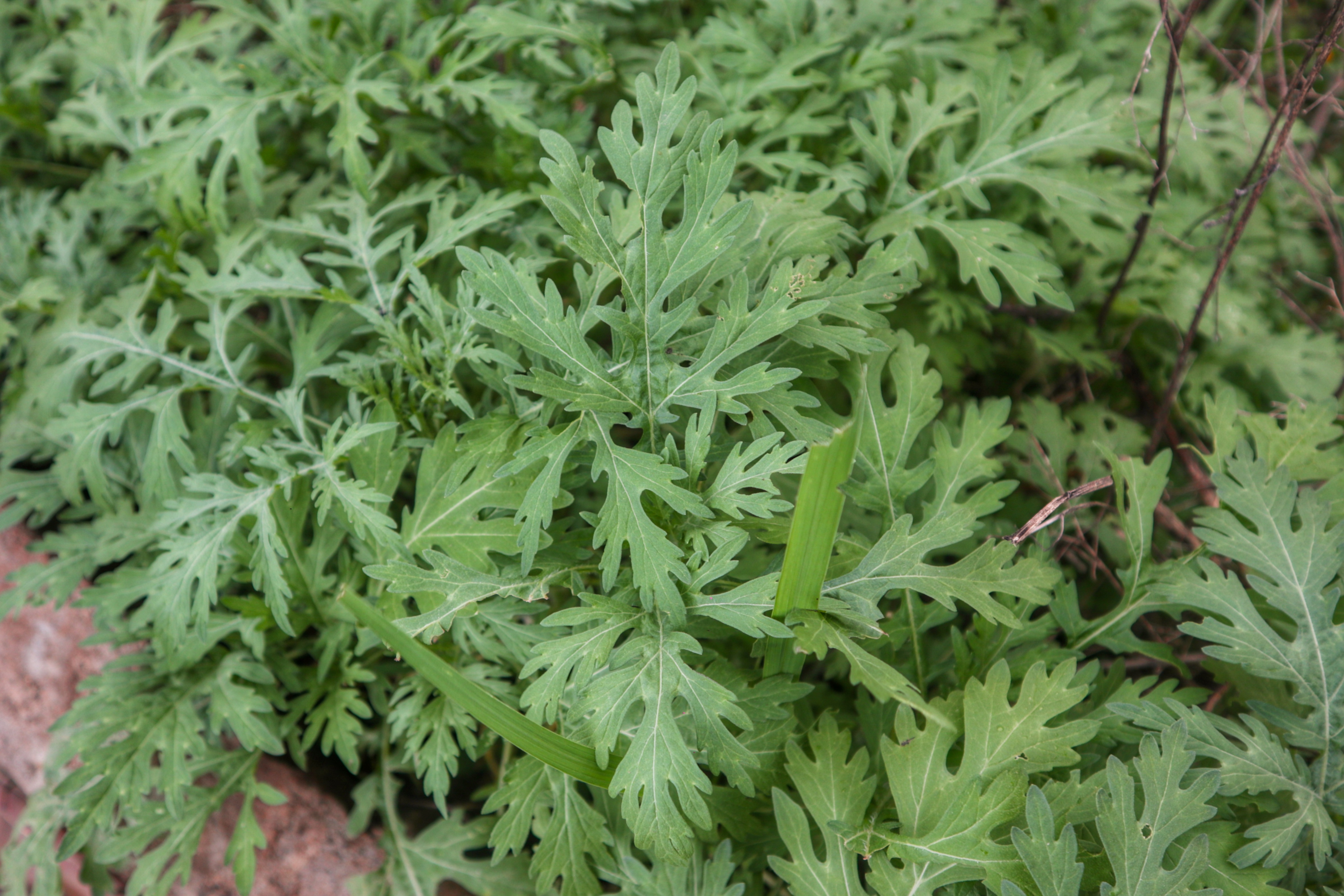
Foliage
Parthenium hysterophorus (parthenium weed); Foliage. India. July 2020.
Public Domain - Released by Apurba Biswas (Apurv013)/via Wikimedia Commons - CC0 1.0
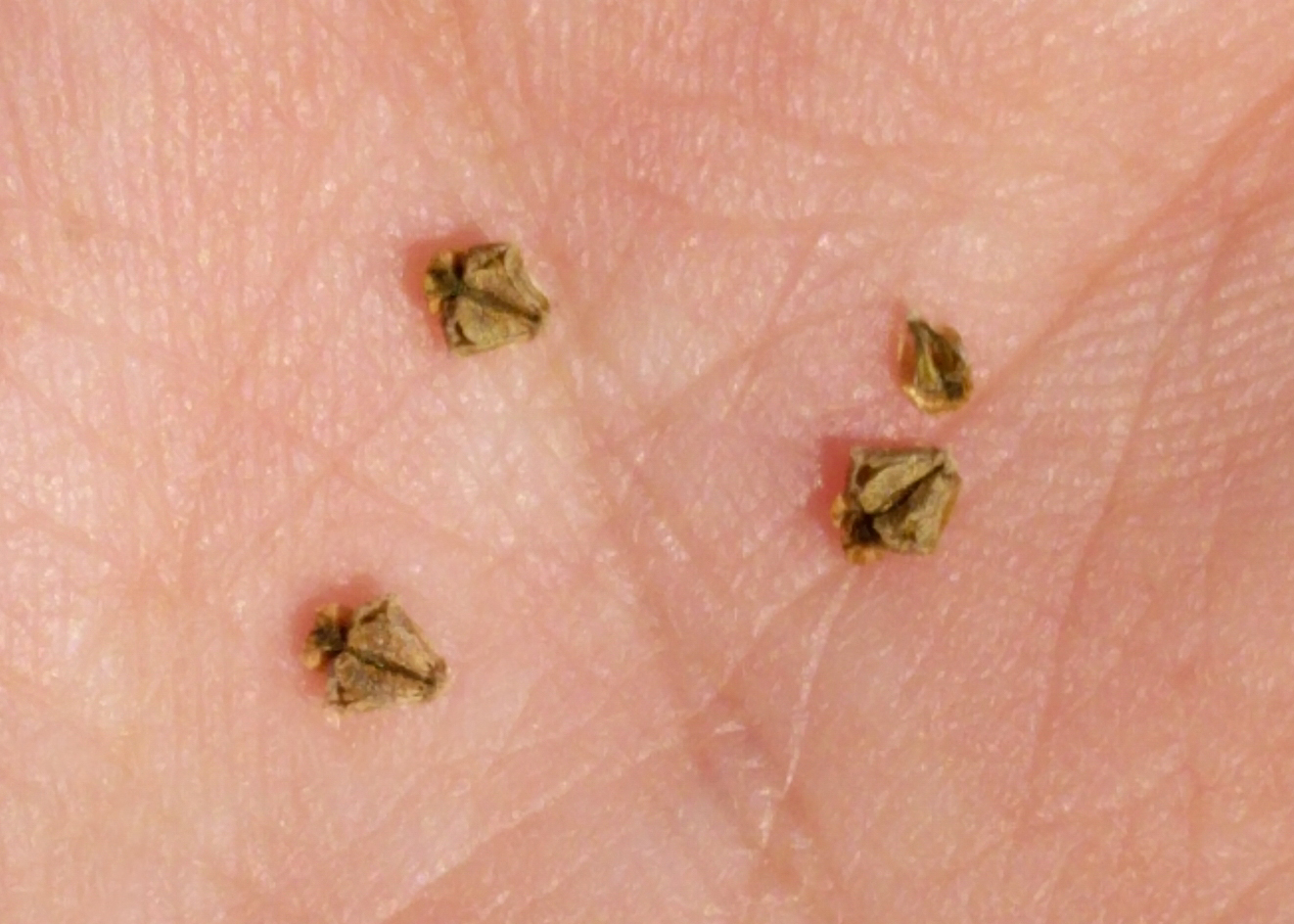
Parthenium hysterophorus (parthenium weed); Seeds. Austin, Texas, USA. September 2017.
©Alison Northup/via iNaturalist - CC BY 4.0
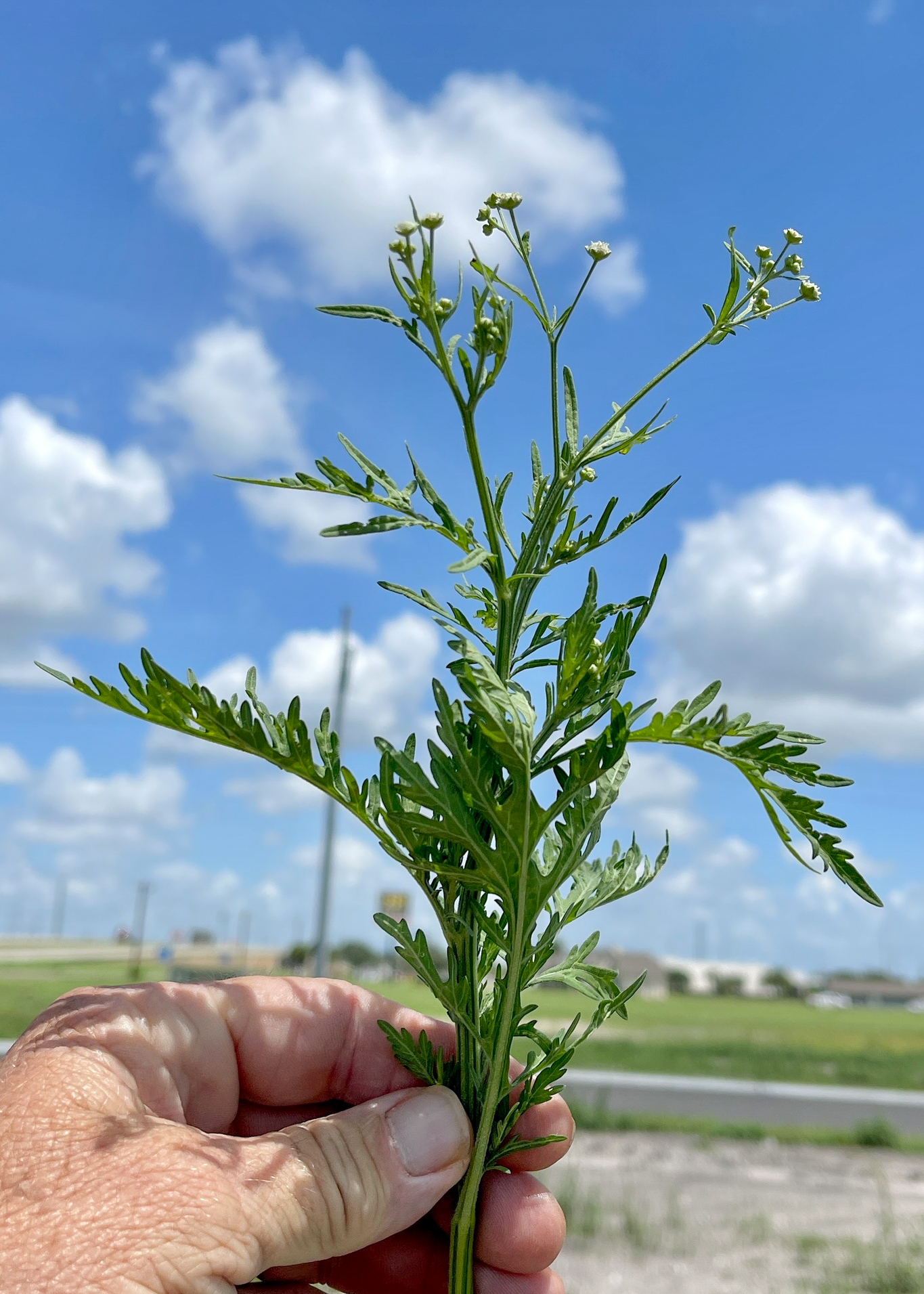
Plant
Parthenium hysterophorus (parthenium weed); Plant. Calallen, Corpus Christi, Texas, USA. August 2022.
©CK Kelly (ck2az)/via iNaturalist - CC BY 4.0
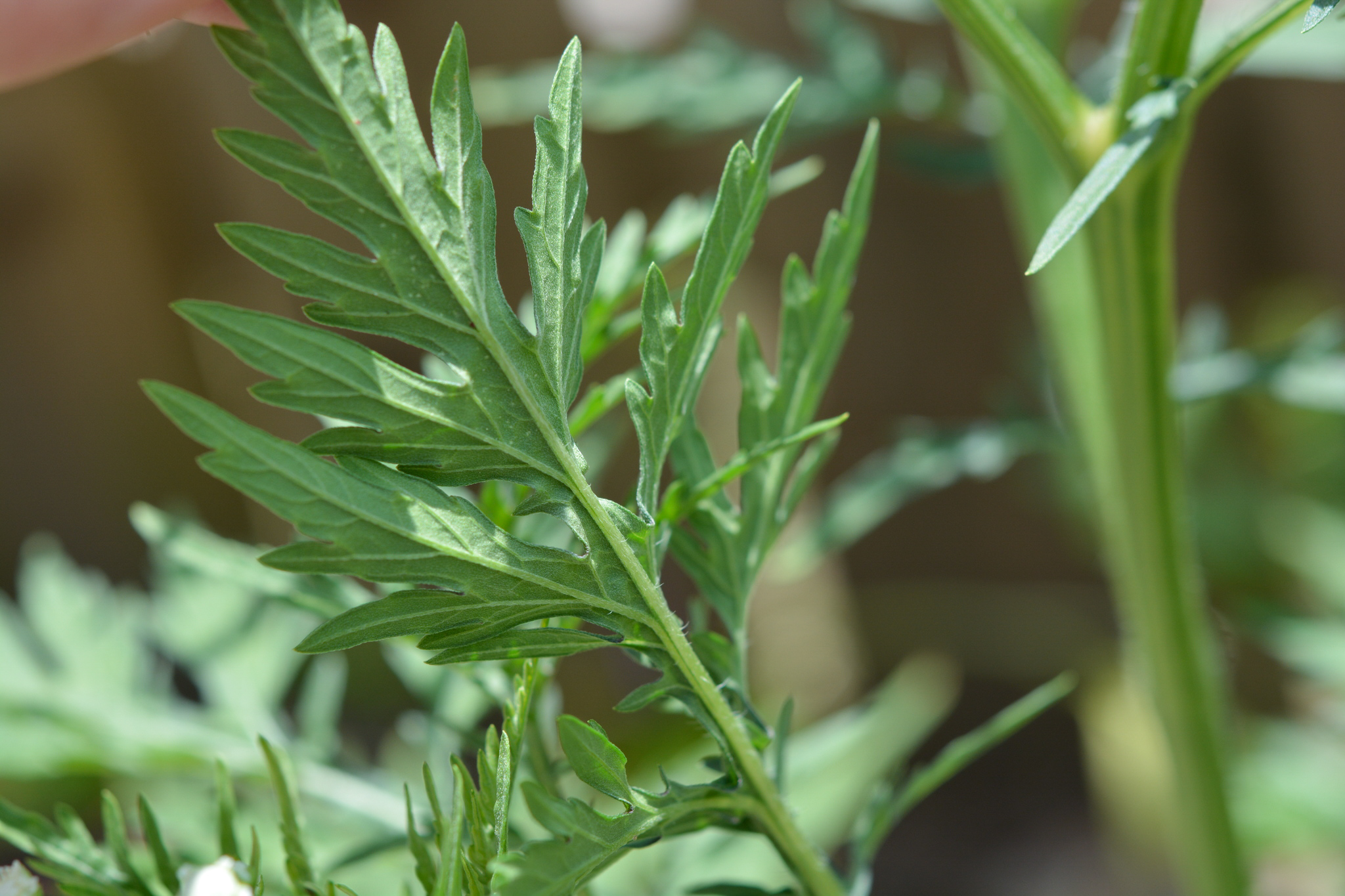
Leaf
Parthenium hysterophorus (parthenium weed); Underside of leaf. Baton Rouge, Louisiana, USA. May 2019.
©Amber M. King (amberenergy)/via iNaturalist - CC BY 4.0
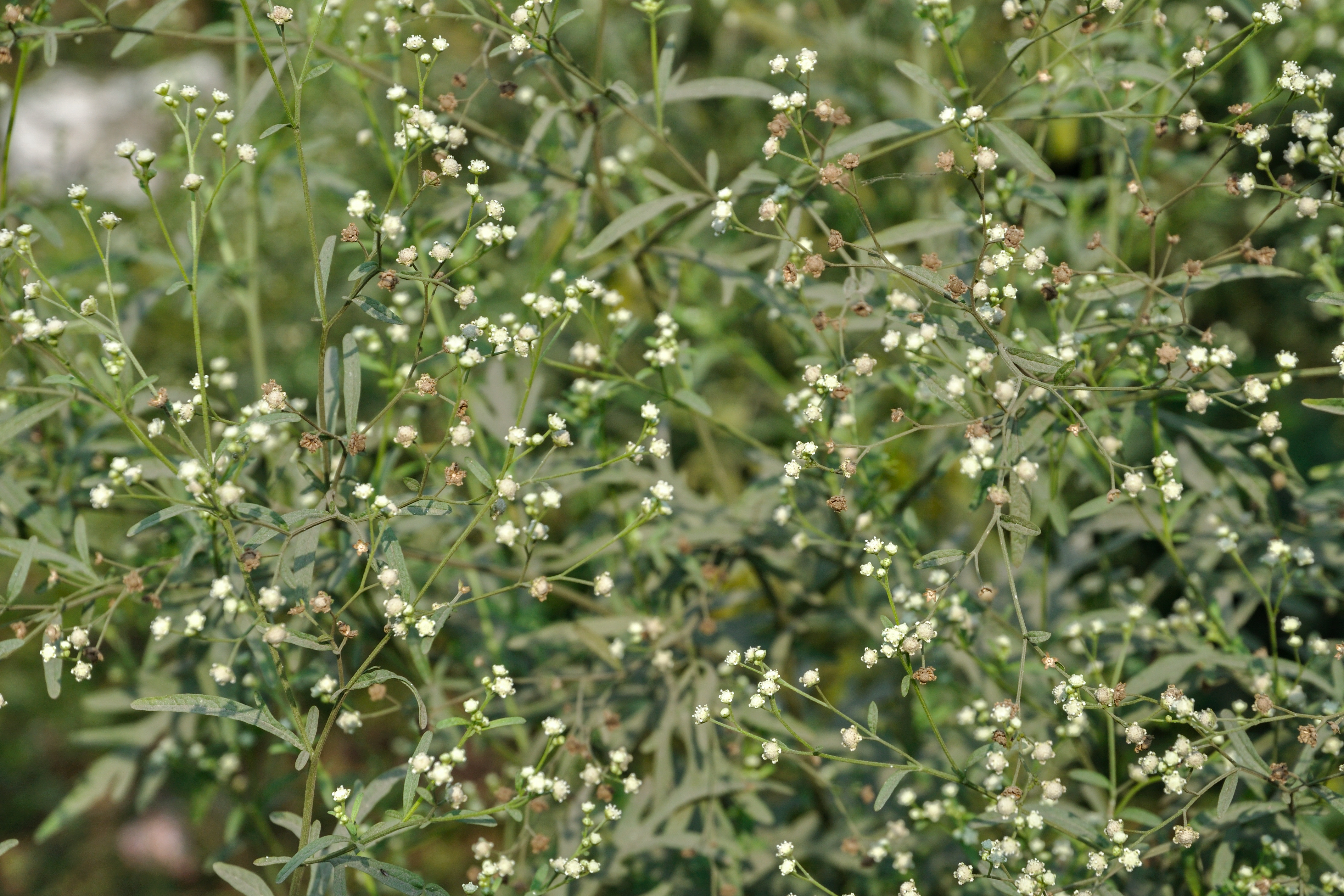
Flowering habit
Parthenium hysterophorus (parthenium weed); Flowering habit. Howrah, India. January 2011.
©Biswarup Ganguly/via Wikimedia Commons - CC BY 3.0
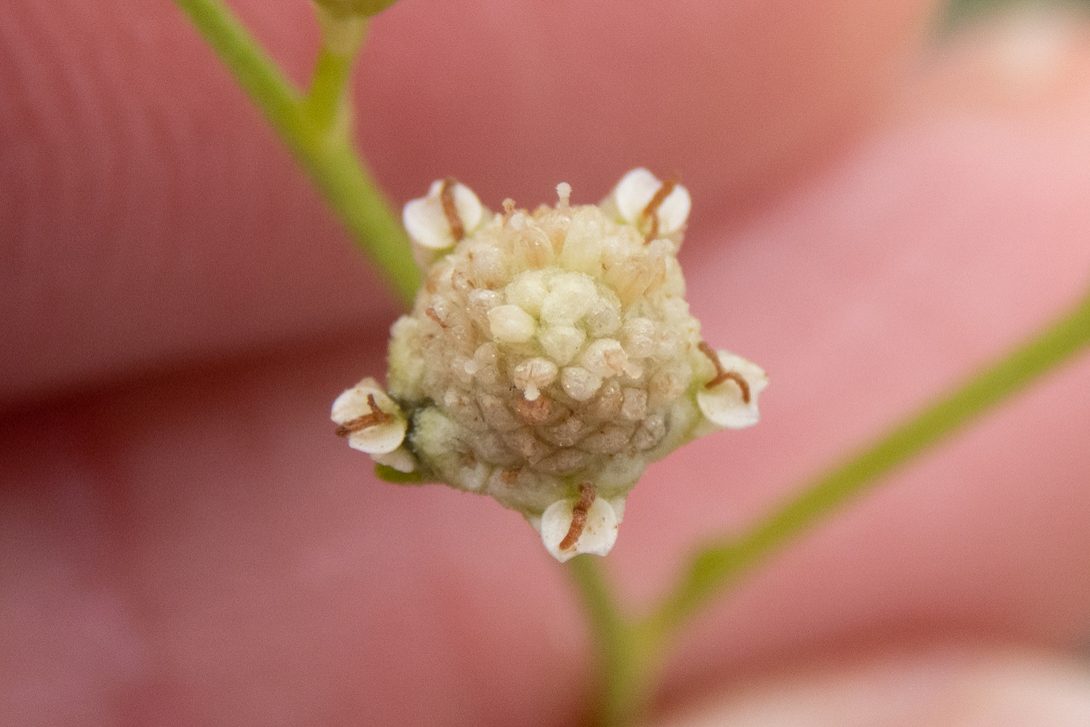
Flowers
Parthenium hysterophorus (parthenium weed); Flowers. Thekwane, South Africa. April 2022.
©Andrew Hankey/via iNaturalist - CC BY 4.0
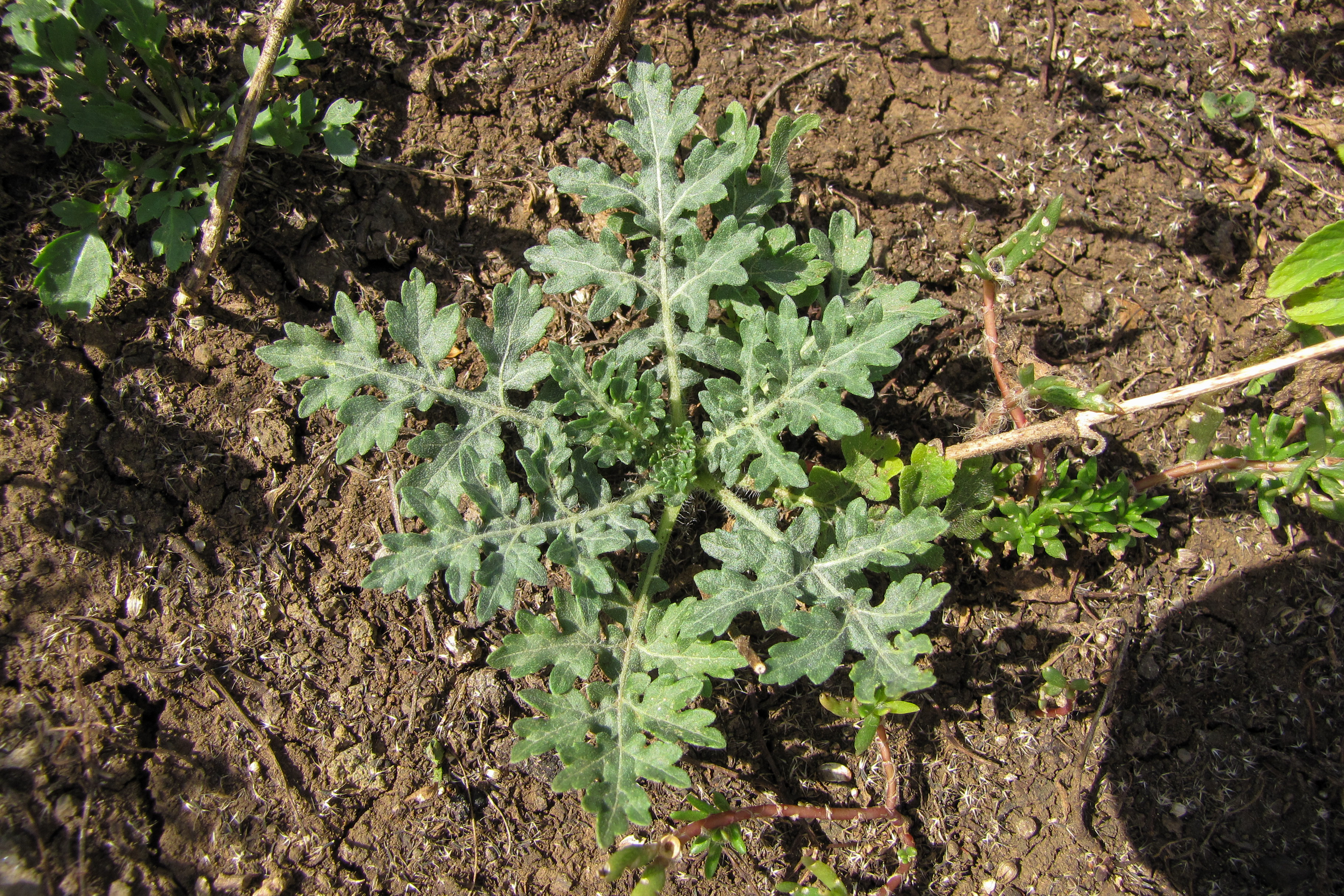
Leaves
Parthenium hysterophorus (parthenium weed); Base rosette leaves. Kīlauea Point National Wildlife Refuge, Kauai, Hawaii. March 2013.
©Forest and Kim Starr/via Starr Environmental - CC BY 4.0
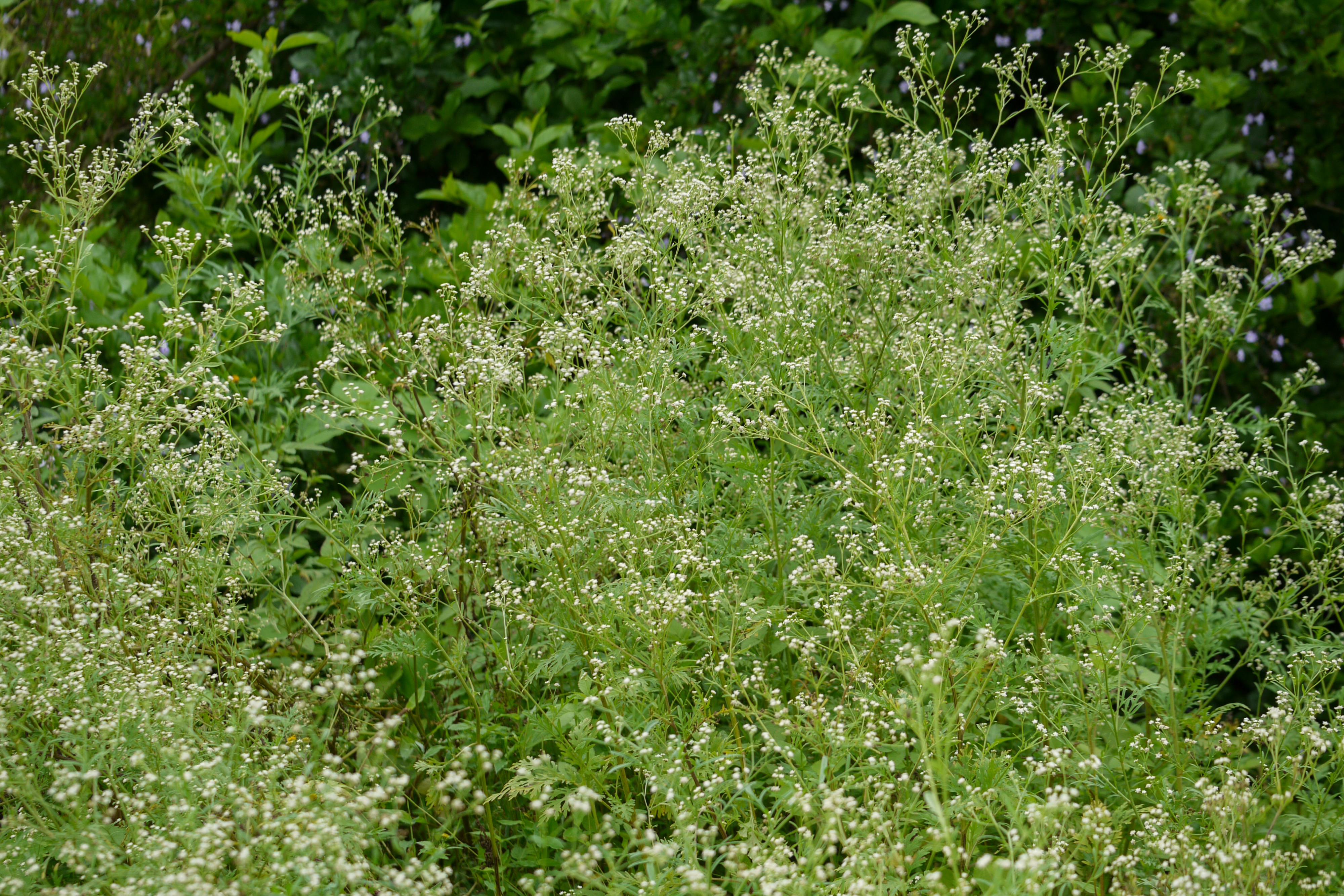
Habit
Parthenium hysterophorus (parthenium weed); Habit. August 2010.
©Dinesh Valke/via Flickr - CC BY-SA 2.0
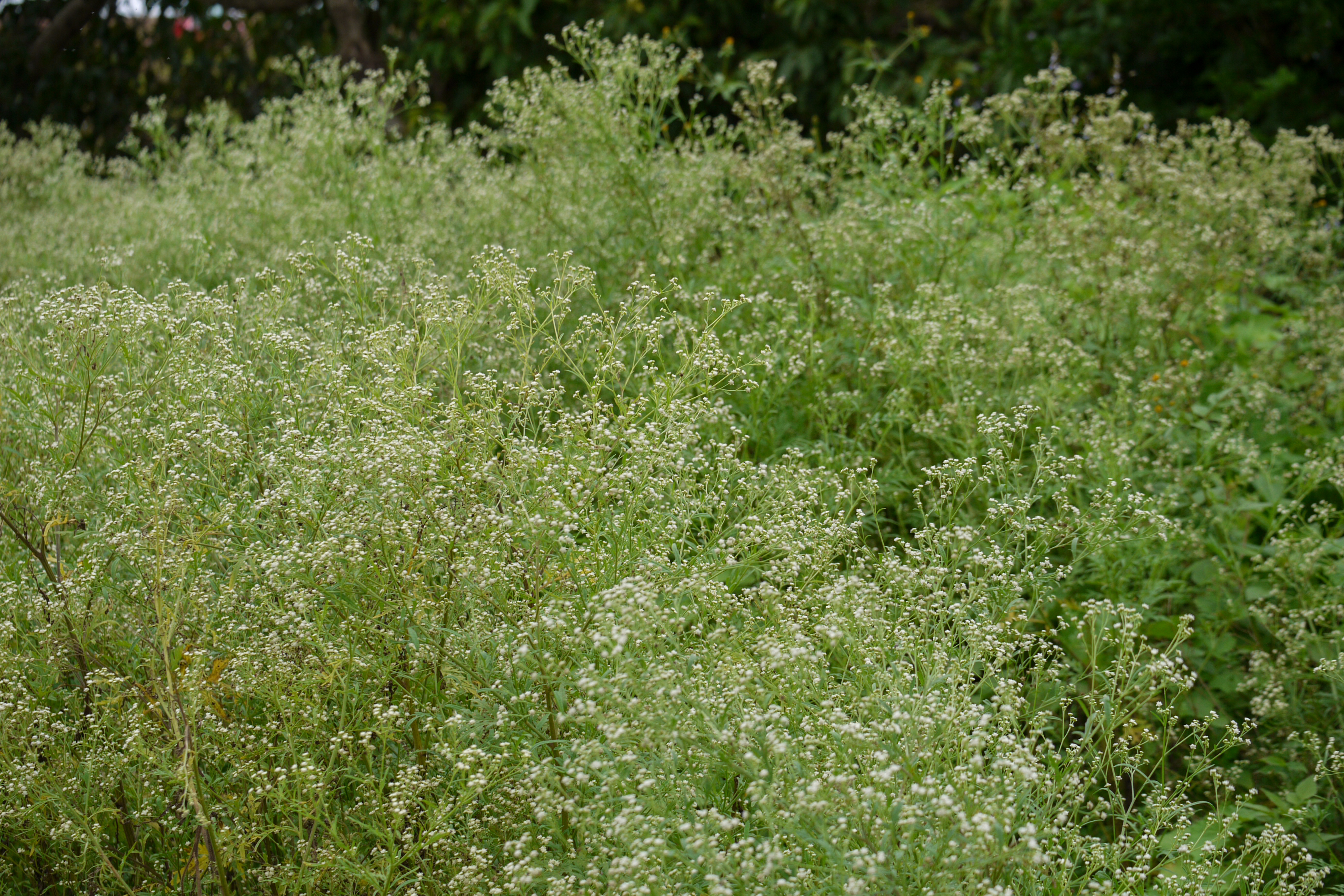
Habit
Parthenium hysterophorus (parthenium weed); Habit. August 2010.
©Dinesh Valke/via Flickr - CC BY-SA 2.0
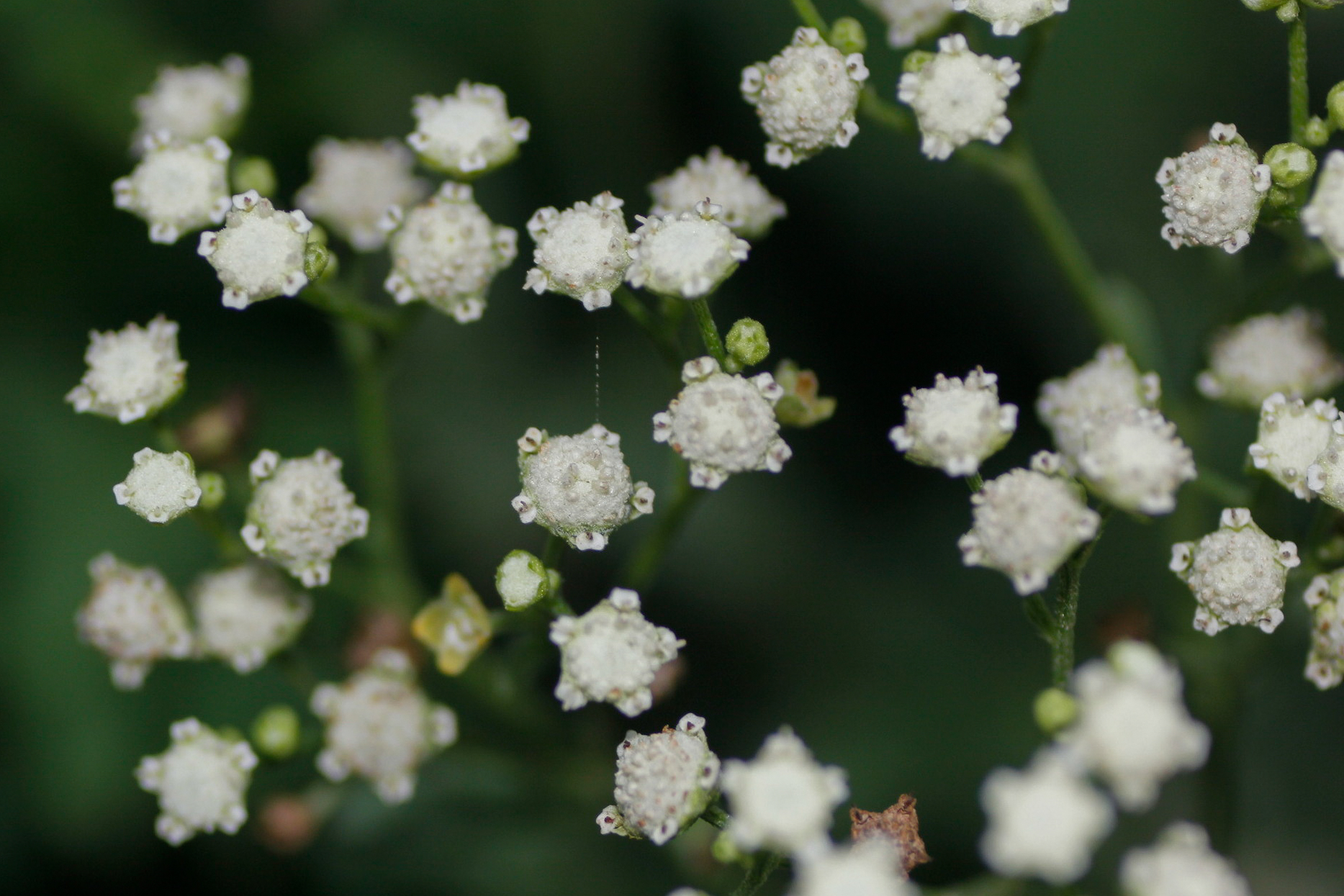
Flowering habit
Parthenium hysterophorus (parthenium weed); Flowering habit. Linares, Nuevo Leon, Mexico. February 2014.
©Juan Cruzado Cortés (juancruzado)/via iNaturalist - CC BY-SA 4.0
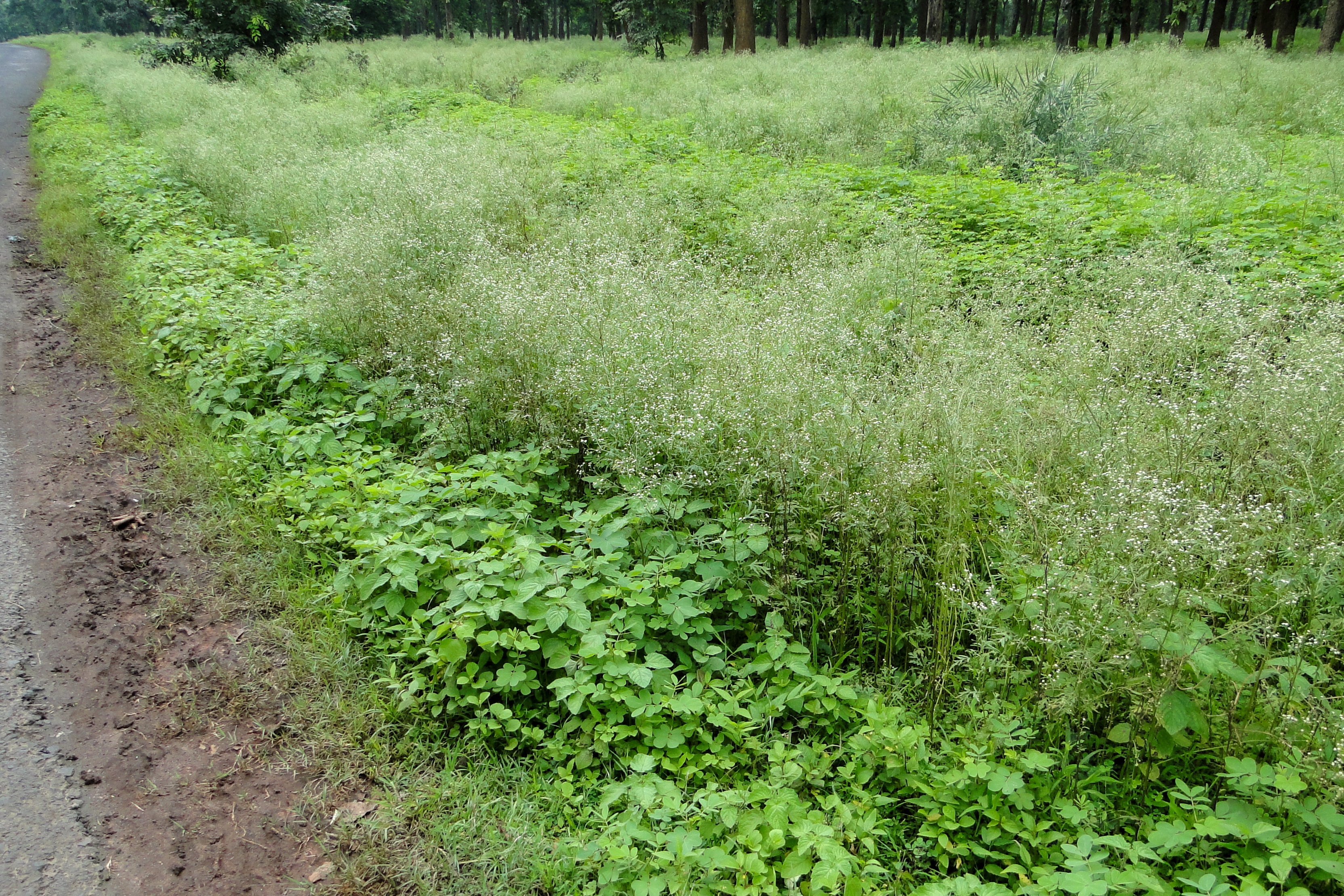
Invasive habit
Parthenium hysterophorus (parthenium weed); Invasive habit. Achanakmar Tiger Reserve, Bilaspur, Chhattisgarh, India. August 2012.
©Pankaj Oudhia/via Wikimedia Commons - CC BY-SA 4.0
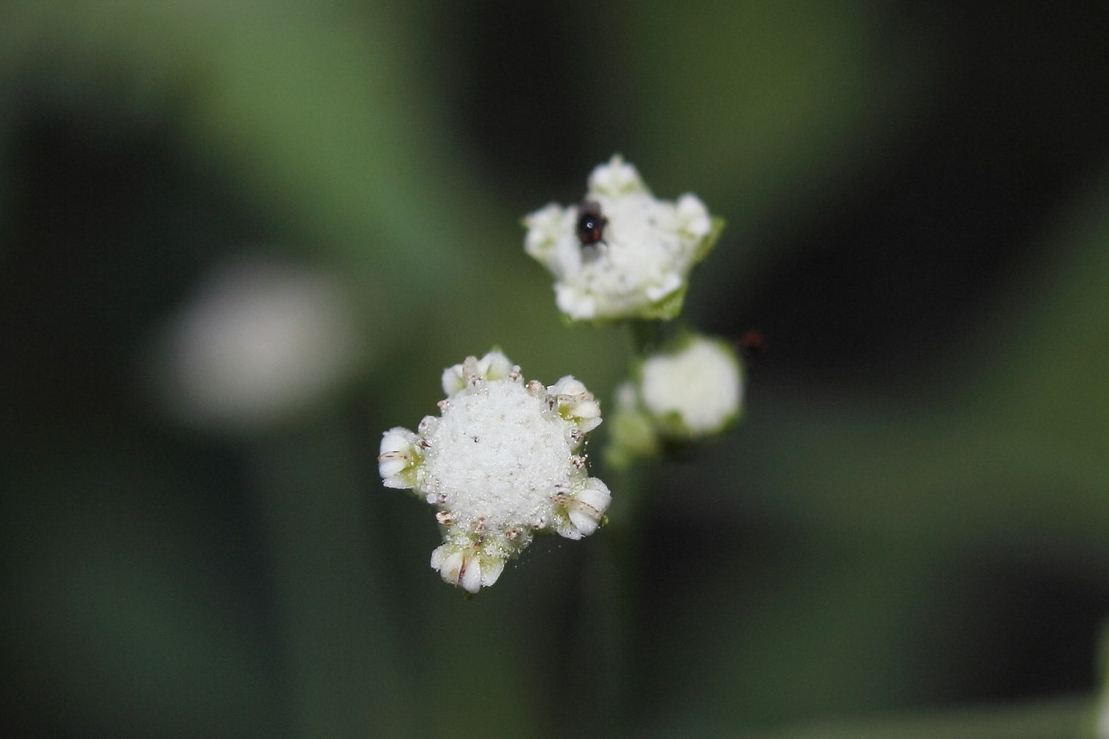
Flowers
Parthenium hysterophorus (parthenium weed); Flowers. Linares, Nuevo Leon, Mexico. January 2014.
©Juan Cruzado Cortés (juancruzado)/via iNaturalist - CC BY-SA 4.0
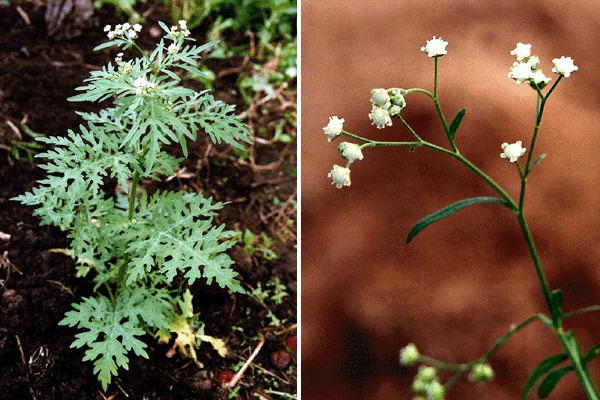
Whole plant and inflorescence
P. hysterophorus plant and flowers.
©S.D. Sawant

Rosette stage
Parthenium weed: rosette stage.
©CABI BioScience
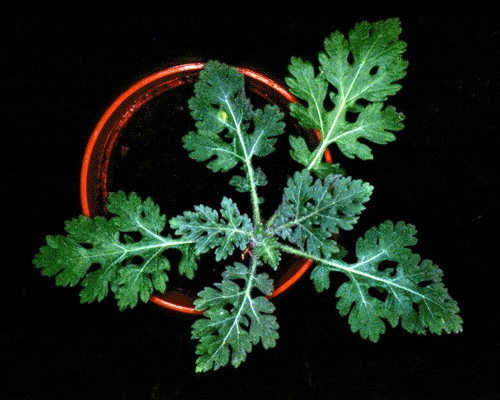
Rosette stage
Parthenium weed: rosette stage.
©CABI BioScience
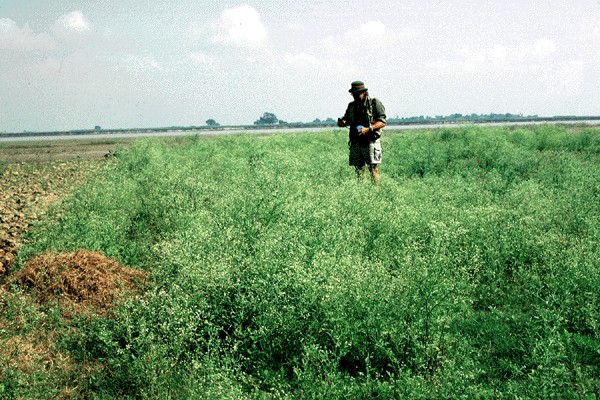
Crop infestation by P. hysterophorus
Parthenium weed: mature flowering stage infesting crops along the Ganges, India.
©CABI BioScience
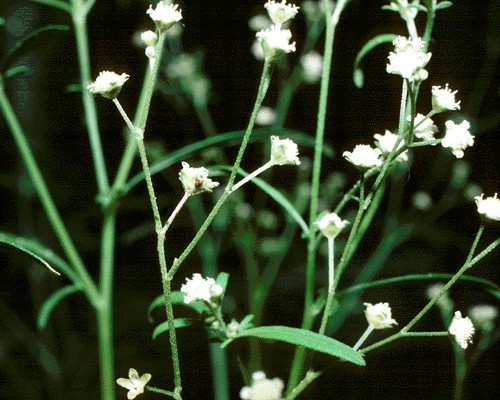
Detail of flower
Parthenium weed: detail of capitula (flower).
©CABI BioScience
Distribution
Host Plants and Other Plants Affected
Prevention and Control
Prevention
As P. hysterophorus seed can be spread via flowing water or can be blown by the wind, the prevention of spread might be difficult. Seed production should be prevented by destroying the plants before flowering or seed setting. The seed can also stay for years in the soil seed bank and the continuous removal of the weed is required until the seed bank is depleted.
The spread of seed through the trading and transport of goods, animals grazing on infested fields, and the transportation of sand, soil and compost from infested areas to uninfested areas, are potential risks for further spread and hence should be controlled through quarantine.
In wastelands and public places such as gardens, recreation areas, parks, roadsides and railway tracks, where it is most serious, control has to be attempted on a community basis by local administrations. In India, campaigns have been attempted using children, the general public, NGOs and others (Bahn et al., 1997; Singh, 1997), and in Ethiopia there was a wide publicity campaign through TV, radio, posters and seminars to bring awareness and educate people (Taye, 2002). Rubaba et al. (2017) suggest investing in surveillance systems in areas or countries of Africa where P. hysterophorus has not yet invaded to do early interventions. One important part of their proposed plan is training the general public in invasive species identification and providing invasive species fact sheets.
Parthenium hysterophorus is declared noxious throughout Queensland, Australia (Navie et al., 1996). It is categorized as P2 (where it must be destroyed) throughout the whole state except in specified areas where it is designated P3 and P4 (where infestations are to be reduced and prevented from spreading). In Queensland, P. hysterophorus seed is declared under the Agricultural Standards Act, which prevents the sale of commercial seed containing prohibited seed (Genn, 1987). Legislation has also been enacted to prevent the movement of vehicles carrying P. hysterophorus seed from Queensland to New South Wales, Australia and penalties have been imposed to deter the illegal entry of such vehicles (Parsons and Cuthbertson, 1992). It is a declared noxious weed in South Africa (Henderson, 2001). However, such prevention and quarantine activities are not exercised in many other countries and the weed is progressing in its invasion from continent to continent and country to country.
SPS Measures
The spread of seed through the trading and transport of goods, animals grazing on infested fields, and the transportation of sand, soil and compost from infested areas to uninfested areas, are potential risks for further spread and hence should be controlled through quarantine.
In wastelands and public places such as gardens, recreation areas, parks, roadsides and railway tracks, where it is most serious, control has to be attempted on a community basis by local administrations. In India, campaigns have been attempted using children, the general public, NGOs and others (Bahn et al., 1997; Singh, 1997), and in Ethiopia there was a wide publicity campaign through TV, radio, posters and seminars to bring awareness and educate people (Taye, 2002). Rubaba et al. (2017) suggest investing in surveillance systems in areas or countries of Africa where P. hysterophorus has not yet invaded to do early interventions. One important part of their proposed plan is training the general public in invasive species identification and providing invasive species fact sheets.
Parthenium hysterophorus is declared noxious throughout Queensland, Australia (Navie et al., 1996). It is categorized as P2 (where it must be destroyed) throughout the whole state except in specified areas where it is designated P3 and P4 (where infestations are to be reduced and prevented from spreading). In Queensland, P. hysterophorus seed is declared under the Agricultural Standards Act, which prevents the sale of commercial seed containing prohibited seed (Genn, 1987). Legislation has also been enacted to prevent the movement of vehicles carrying P. hysterophorus seed from Queensland to New South Wales, Australia and penalties have been imposed to deter the illegal entry of such vehicles (Parsons and Cuthbertson, 1992). It is a declared noxious weed in South Africa (Henderson, 2001). However, such prevention and quarantine activities are not exercised in many other countries and the weed is progressing in its invasion from continent to continent and country to country.
SPS Measures
Quarantine and eradication measurements are in effect for P. hysterophorus in Europe (EPPO, 2018). Australian authorities have imposed strict quarantines on contaminated equipment and stock to avoid spread into new areas (PIER, 2018).
Control
Control
Eradication
In Kenya, the Suppression of Noxious Weeds Act of 2010 (CAP 325) obliges land owners to remove the species from their properties (Rubaba et al., 2017). The species is regulated as a quarantine pest in Europe under the EU IAS Regulation introduced in 2014 (EPPO, 2018), restricting its sale and movement, and requiring government agencies to undertake eradication programs.
Physical/mechanical control
Kaur et al. (2014) recommends the manual uprooting of the plants before flowering and seed set, followed by sowing desirable crops or pasture species. In some African countries with light infestations where labour is not too expensive, the use of machetes, hand pulling and burning of the species are a common practice (Rubaba et al., 2017). Physical removal by hand-pulling poses health risks and has not been recommended in Australia (Parsons and Cuthbertson, 1992). Mechanical treatments, such as grading, mowing, slashing and ploughing are also considered inappropriate since they may promote seed dispersal as well as rapid regeneration from lateral shoots close to the ground (Gupta and Sharma, 1977; Navie et al., 1996). Fire has been used to control the first flush of emergent weeds at the beginning of the rains in Australia but is only considered to be a short-term control measure (Holman, 1981). A study by Vogler et al. (2002) showed that fire created open niches in the landscape, into which larger number of parthenium seeds were able to germinate in the absence of vegetation. Therefore, management of P. hysterophorus in pastures through burning is not considered to be an option.
Physical/mechanical control
Kaur et al. (2014) recommends the manual uprooting of the plants before flowering and seed set, followed by sowing desirable crops or pasture species. In some African countries with light infestations where labour is not too expensive, the use of machetes, hand pulling and burning of the species are a common practice (Rubaba et al., 2017). Physical removal by hand-pulling poses health risks and has not been recommended in Australia (Parsons and Cuthbertson, 1992). Mechanical treatments, such as grading, mowing, slashing and ploughing are also considered inappropriate since they may promote seed dispersal as well as rapid regeneration from lateral shoots close to the ground (Gupta and Sharma, 1977; Navie et al., 1996). Fire has been used to control the first flush of emergent weeds at the beginning of the rains in Australia but is only considered to be a short-term control measure (Holman, 1981). A study by Vogler et al. (2002) showed that fire created open niches in the landscape, into which larger number of parthenium seeds were able to germinate in the absence of vegetation. Therefore, management of P. hysterophorus in pastures through burning is not considered to be an option.
Biological control
The use of insect and fungal pathogens and the exploitation of allelopathic plants is considered by Kaur et al. (2014) as the most economical and practical way to manage the infestations of the species. Biological control has been, and continues to be, considered the best long-term or sustainable solution to the parthenium weed problem in Australia (Haseler, 1976; McFadyen, 1992) and because of the vast areas and the socio-economics involved, this approach has also been proposed for India (Singh, 1997). South Africa was the first country in Africa to implement a biological control program against the species in 2003 (Rubaba et al., 2017). Four host-specific biocontrol agents have been released sequentially since 2010 after evaluation of their suitability, with variable establishment and spread (Strathie et al., 2016).
The use of insects as biocontrol agents had been tried in various countries (Kaur et al., 2014). Searches for, and evaluation of, coevolved natural enemies have been conducted in the neotropics since 1977. So far, nine insect species and two fungal pathogens have been introduced into Australia as classical biological control agents (Julien, 1992; McClay et al., 1995; Navie et al., 1996; Dhileepan and McFadyen, 1997; Evans, 1997a). Callander and Dhileepan (2016) report that most of these agents have become established and have proven effective in central Queensland, but that the weed is now spreading further into southern Queensland where the biocontrol agents are not present. Several of the agents are therefore now being redistributed into south and southeast Queensland.
The use of insects as biocontrol agents had been tried in various countries (Kaur et al., 2014). Searches for, and evaluation of, coevolved natural enemies have been conducted in the neotropics since 1977. So far, nine insect species and two fungal pathogens have been introduced into Australia as classical biological control agents (Julien, 1992; McClay et al., 1995; Navie et al., 1996; Dhileepan and McFadyen, 1997; Evans, 1997a). Callander and Dhileepan (2016) report that most of these agents have become established and have proven effective in central Queensland, but that the weed is now spreading further into southern Queensland where the biocontrol agents are not present. Several of the agents are therefore now being redistributed into south and southeast Queensland.
Among the established insect biocontrol agents, the leaf-feeding beetle Zygogramma bicolorata, the stem-galling moth Epiblema strenuana, the stem-boring beetle Listronotus setosipennis, and the seed-feeding weevil Smicronyx lutulentus, are proving to be the most successful when climatic factors are favourable (McFadyen, 1992; Dhileepan and McFadyen, 1997; Evans, 1997a). Some control of P. hysterophorus has also been achieved in India with Z. bicolorata (Jayanth and Visalakshy, 1994; Singh, 1997; Sarkate and Pawar, 2006), although there has been controversy concerning its taxonomy and host specificity (Jayanth et al., 1993; Singh, 1997). Shabbir et al. (2016) reported that Z. bicolorata was most effective when applied in higher densities and at early growth stages of the weed. The distribution of this leaf beetle in South Asia was investigated by Dhileepan and Senaratne (2009), when it was present in many states in India, and in the Punjab region of Pakistan. Shrestha et al. (2011) reported that Z. bicolorata arrived in the Kathmandu Valley of Nepal in August 2010, and that by September it had spread over half of the valley areas where P. hysterophorus was present, although damage to the weed was only appreciable at one site.
Zygogramma bicolorata has been seen attacking sunflowers in India and the use of Epiblema strenuata has not been effective, as it was found affecting Guizotia abyssinica crops (Kaur et al., 2014). More recently, Z. bicolorata and L. setosipennis have been released in South Africa and S. lutulentus is being evaluated under quarantine. Before approval as a biocontrol agent in South Africa in 2013, extensive testing suggested that Z. bicolorata would not become a pest of sunflowers in the country (McConnachie, 2015).
The rust fungus, Puccinia abrupta var. partheniicola, is a prominent natural enemy in the semi-arid uplands of Mexico (Evans, 1987a, b), but since its release in Queensland in 1992, climatic conditions have been largely unfavourable (Evans, 1997a, b). It was accidentally introduced into Kenya (Evans, 1987a) and Ethiopia in mid-altitudes (1400-2500 masl) with disease incidence up to 100% in some locations (Taye et al., 2002a). Screening of another rust species (Puccinia melampodii) from Mexico was carried out (Evans, 1997b; Seier et al., 1997) and released in Australia in the summer of 1999/2000 (PAG, 2000). This fungus was later renamed Puccinia xanthii Schwein. var. parthenii-hysterophorae Seier, H.C.Evans & Á.Romero (Seier et al., 2009). Retief et al. (2013) report on specificity testing carried out in quarantine facilities in South Africa, and conclude that the fungus is suitable for release as a biological control agent of P. hysterophorus in South Africa. The authors suggest that this species has more potential for biocontrol in South Africa than Puccinia abrupta, which may have little impact in the low-altitude, high-temperature areas of the country where the weed is spreading.
In India, the mycoherbicide potential of plurivorous fungal pathogens belonging to the genera Fusarium, Colletotrichum, Curvularia,Myrothecium and Sclerotium, has and is being evaluated (Mishra et al., 1995; Evans, 1997a). Parthenium phyllody disease caused by the phytoplasma of faba bean phyllody group (FBP) was reported to reduce seed production by 85% (Taye et al., 2002b) and is being evaluated for use as a biological control agent in Ethiopia. Kaur and Aggarwal (2017) have tested an Alternaria isolate found on the weed, and report that it is worth investigating as a mycoherbicide for control of parthenium. Metabolites of Alternaria japonica and filtrates of Alternaria macrospora have caused significant damage to Parthenium (Kaur et al., 2015; Javaid et al., 2017).
The use of antagonistic, competitor plants, such as Cassia spp. and Tagetes spp., has been recommended to control and replace P. hysterophorus in India (Mahadevappa and Ramaiah, 1988; Evans, 1997a; Mahadevappa, 1997; Singh, 1997). In Australia, Bowen et al. (2007) tested a number of grass and legume species against the growth of parthenium weed plants and identified further species that could suppress weed growth. Recently, Khan et al. (2013) tested a number of native and introduced pasture species and identified several of them to be suppressive against parthenium weed in both glasshouse and field conditions. The sowing of selected pasture plants in infested areas can suppress the growth of parthenium weed by as much as 80% and also provide improved fodder for stock (Adkins et al., 2012). Shabbir et al. (2013) showed that the suppressive plants and biological control agents can act synergistically to significantly reduce both the biomass and seed production of parthenium weed under field conditions. The suppressive plants strategy is easy to apply, sustainable over time, profitable under a wide range of environmental conditions and promotes native plant biodiversity. Species reported as effectively outcompeting P. hysterophorus are Cassia sericea, C. tora, C. auriculata, Croton bonplandianum, Amaranthus spinosus, Tephrosia purpurea, Hyptis suaveolens, Sida spinosa, and Mirabilis jalapa. Extracts of Imperata cylindrica, Desmostachya bipinnata, Otcantium annulatum, Sorghum halepenseDicanthium annulatum, Cenchrus pennisetiformis, Azadirachta indica, Aegle marmelos and Eucalyptus tereticornis are reported as inhibiting the germination and/or growth of P. hysterophorus (Kaur et al., 2014).
In India, the mycoherbicide potential of plurivorous fungal pathogens belonging to the genera Fusarium, Colletotrichum, Curvularia,Myrothecium and Sclerotium, has and is being evaluated (Mishra et al., 1995; Evans, 1997a). Parthenium phyllody disease caused by the phytoplasma of faba bean phyllody group (FBP) was reported to reduce seed production by 85% (Taye et al., 2002b) and is being evaluated for use as a biological control agent in Ethiopia. Kaur and Aggarwal (2017) have tested an Alternaria isolate found on the weed, and report that it is worth investigating as a mycoherbicide for control of parthenium. Metabolites of Alternaria japonica and filtrates of Alternaria macrospora have caused significant damage to Parthenium (Kaur et al., 2015; Javaid et al., 2017).
The use of antagonistic, competitor plants, such as Cassia spp. and Tagetes spp., has been recommended to control and replace P. hysterophorus in India (Mahadevappa and Ramaiah, 1988; Evans, 1997a; Mahadevappa, 1997; Singh, 1997). In Australia, Bowen et al. (2007) tested a number of grass and legume species against the growth of parthenium weed plants and identified further species that could suppress weed growth. Recently, Khan et al. (2013) tested a number of native and introduced pasture species and identified several of them to be suppressive against parthenium weed in both glasshouse and field conditions. The sowing of selected pasture plants in infested areas can suppress the growth of parthenium weed by as much as 80% and also provide improved fodder for stock (Adkins et al., 2012). Shabbir et al. (2013) showed that the suppressive plants and biological control agents can act synergistically to significantly reduce both the biomass and seed production of parthenium weed under field conditions. The suppressive plants strategy is easy to apply, sustainable over time, profitable under a wide range of environmental conditions and promotes native plant biodiversity. Species reported as effectively outcompeting P. hysterophorus are Cassia sericea, C. tora, C. auriculata, Croton bonplandianum, Amaranthus spinosus, Tephrosia purpurea, Hyptis suaveolens, Sida spinosa, and Mirabilis jalapa. Extracts of Imperata cylindrica, Desmostachya bipinnata, Otcantium annulatum, Sorghum halepenseDicanthium annulatum, Cenchrus pennisetiformis, Azadirachta indica, Aegle marmelos and Eucalyptus tereticornis are reported as inhibiting the germination and/or growth of P. hysterophorus (Kaur et al., 2014).
Chemical Control
Due to the variable regulations around (de-)registration of pesticides, we are for the moment not including any specific chemical control recommendations. For further information, we recommend you visit the following resources:
•
EU pesticides database (http://ec.europa.eu/food/plant/pesticides/eu-pesticides-database/)
•
PAN pesticide database (www.pesticideinfo.org)
•
Your national pesticide guide
Information & Authors
Information
Published In
Copyright
Copyright © CABI. CABI is a registered EU trademark. This article is published under a Attribution-NonCommercial-NoDerivatives 4.0 International (CC BY-NC-ND 4.0)
History
Published online: 9 October 2023
Language
English
Authors
Metrics & Citations
Metrics
SCITE_
Citations
Export citation
Select the format you want to export the citations of this publication.
EXPORT CITATIONSExport Citation
View Options
View options
Get Access
Login Options
Check if you access through your login credentials or your institution to get full access on this article.


